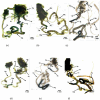Evaluation of the toxic potential of Bisphenol-A glycidylmethacrylate (BisGMA) on the third instar larvae of transgenic Drosophila
- PMID: 38450176
- PMCID: PMC10913391
- DOI: 10.1093/toxres/tfae026
Evaluation of the toxic potential of Bisphenol-A glycidylmethacrylate (BisGMA) on the third instar larvae of transgenic Drosophila
Abstract
Introduction: In the present study the cytotoxic and genotoxic effects of Bisphenol-A glycidyl methacrylate (BisGMA) was studied on the third instar larvae of transgenic Drosophila melanogaster (hsp70-lacZ)Bg9.
Materials and methods: The concentration of BisGMA i.e. 0.005, 0.010, 0.015 and 0.020 M were established in diet and the larvae were allowed to feed on it for 24 h.
Results: A dose dependent significant increase in the activity of β-galactosidase was observed compared to control. A significant dose dependent tissue damage was observed in the larvae exposed to 0.010, 0.015 and 0.020 M of BisGMA compared to control. A dose dependent significant increase in the Oxidative stress markers was observed compared to control. BisGMA also exhibit significant DNA damaged in the third instar larvae of transgenic D. melanogaster (hsp70-lacZ)Bg9 at the doses of 0.010, 0.015 and 0.020 M compared to control.
Conclusion: BisGMA at 0.010, 0.015 and 0.020 M was found to be cytotoxic for the third instar larvae of transgenic D. melanogaster (hsp70-lacZ) Bg9.
Keywords: Drosophila; bisphenol-A-glycidylmethacrylate; cytotoxicity; genotoxicity; oxidative stress.
© The Author(s) 2024. Published by Oxford University Press. All rights reserved. For Permissions, please email: journals.permissions@oup.com.
Conflict of interest statement
None declared.
Figures







Similar articles
-
Effect of L-ascorbic Acid on the hsp70 Expression and Tissue Damage in the Third Instar Larvae of Transgenic Drosophila melanogaster (hsp70-lacZ) Bg(9).Toxicol Int. 2012 Sep;19(3):301-5. doi: 10.4103/0971-6580.103673. Toxicol Int. 2012. PMID: 23293470 Free PMC article.
-
Evaluation of the toxic potential of arecoline toward the third instar larvae of transgenic Drosophila melanogaster (hsp70-lacZ) Bg9.Toxicol Res (Camb). 2018 Mar 20;7(3):432-443. doi: 10.1039/c7tx00305f. eCollection 2018 May 8. Toxicol Res (Camb). 2018. PMID: 30090593 Free PMC article.
-
Evaluation of the toxic potential of cefotaxime in the third instar larvae of transgenic Drosophila melanogaster.Chem Biol Interact. 2015 May 25;233:71-80. doi: 10.1016/j.cbi.2015.03.004. Epub 2015 Mar 11. Chem Biol Interact. 2015. PMID: 25770931
-
Evaluation of Bis(2-ethylhexyl) phthalate toxicity on the third instar larvae of transgenic Drosophila melanogaster (hsp70-lacZ) Bg9.Food Chem Toxicol. 2024 Feb;184:114425. doi: 10.1016/j.fct.2023.114425. Epub 2023 Dec 29. Food Chem Toxicol. 2024. PMID: 38160779
-
Validation of 1-methyl-2-phenylindole method for estimating lipid peroxidation in the third instar larvae of transgenic Drosophila melanogaster (hsp70-lacZ)Bg (9.).Pharm Methods. 2012 Jul;3(2):94-7. doi: 10.4103/2229-4708.103883. Pharm Methods. 2012. PMID: 23781486 Free PMC article.
References
-
- Alkadhimi A, Motamedi F. Orthodontic adhesives for fixed appliances: a review of available systems. Dent Update. 2019:46(8):742–758.
-
- Gange P. The evolution of bonding in orthodontics. Am J Orthod Dentofacial Orthop. 2015:147(4):S56–S63. - PubMed
-
- Papakonstantinou AE, Eliades T, Cellesi F, Watts DC, Silikas N. Evaluation of UDMA's potential as a substitute for Bis-GMA in orthodontic adhesives. Dent Mater. 2013:29(8):898–905. - PubMed
-
- Ahrari F, Tavakkol Afshari J, Poosti M, Brook A. Cytotoxicity of orthodontic bonding adhesive resins on human oral fibroblasts. Eur J Orthod. 2010:32(6):688–692. - PubMed
-
- Angiero F, Farronato G, Dessy E, Magistro S, Seramondi R, Farronato D, Benedicenti S, Tetè S. Evaluation of the cytotoxic and genotoxic effects of orthodontic bonding adhesives upon human gingival papillae through immunohistochemical expression of p53, p63 and p16. Anticancer Res. 2009:29(10):3983–3987. - PubMed
LinkOut - more resources
Full Text Sources
Molecular Biology Databases

